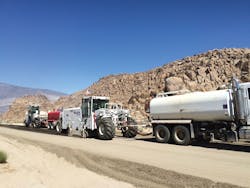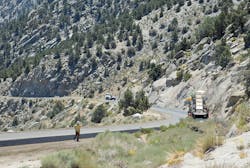Paving the gateway
Mount Whitney, best known as the highest peak in the contiguous U.S., graces the Sierra Nevada mountain range in California with its towering presence at Sequoia National Park and Inyo National Forest at an elevation of 14,505 ft.
Serving as the gateway to this colossal summit is Whitney Portal, the mountain’s trailhead, which sees 10,000 people per year apply for permits to hike. Just west of Lone Pine, this trail is accessible to eager hikers through Whitney Portal Road.
Reconstruction of Whitney Portal Road came about because of a funding request from Inyo County for the 2016 season, with repaving and safety repairs cited as the road’s most critical needs. The county contracted with Hat Creek Construction & Materials Inc. for a $10.8 million full-depth reclamation (FDR) project.
Before the project began, Whitney Portal Road was inflicted with large thermal cracks, roughly 4-6 in. wide and 3-4 in. deep. “When you drove on the road before, there were almost constant speed bumps down the road probably because of the elevation,” Project Manager Tony Bolman told Roads & Bridges.
The project began at the Mt. Whitney parking area and trailhead, and continued downhill for 11.2 miles, terminating about 0.5 miles from the intersection of U.S. 395 in Lone Pine, Calif. The project crossed through a variety of terrains beginning at an elevation of 8,500 ft in steep and narrow mountainous terrain, stretching all the way to the comparatively barren Owens Valley at 3,500 ft.
“So the lower portion, the lower half of the job, was a kind of desert,” Bolman said, “and then the upper half of it was mountain.”
Such a challenge helped earn this dynamic project a 2017 Roads & Bridges/ARRA Recycling Award in the Full-Depth Reclamation category.
Crews had to contend with an environment inhospitable to its haul trucks—to the point that contractors had a difficult time finding hauling subcontractors willing to work on the project.
Getting stuck
One of the major reasons for the overhaul of the Whitney Portal Road was to widen it to accommodate cyclists and other travelers with a shared-use shoulder. This particular corridor is known as one of the toughest bicycling roads in the country due to its steepness, and the contractor certainly faced some difficulty in the paving process as a result. “It was definitely a challenge with it being so steep,” Bolman said. “There were areas of the project, the upper portion, where it was over 14% grade. So pulverizing it wasn’t too bad, but paving it definitely was.”
The team at Hat Creek mostly used double-bottom dump trailers on the project. According to Bolman, the trucks would often get stuck and would need to be pulled out, both before and after dumping, even in the lower sections of the project where the road was 7-8% grade. Since so many trucks would get stuck on the road, it became a struggle for the contractor to find trucks that were willing to come work on the project. “As soon as they heard Whitney Portal Road and knew how steep it was, they wouldn’t come work on it,” Bolman said. “So the trucking was definitely a challenge for sure.”
For the aggregate, the contractor used a 3⁄4-in. mix and PG 64-28 binder. The team used a Roadtec 1500 shuttle Buggy material transfer vehicle to haul the mix about an hour and a half to the project site. A Caterpillar tracked asphalt road paver and road grader were both used on the reclamation project.
Federal highway regulations specify two lifts of asphalt on a project like Whitney Portal Road. “They always spec two lifts even if it’s just 1.5-in. lifts because they get a better ride, but it’s challenging on the first lift to do a 1.5-in. lift with three-quarter aggregate on a pulverized surface,” Bolman said. Both the lower and upper portions were 3.5 in. total and were done in two lifts.
Pulverizing as recycling
Full-depth reclamation was implemented on this project in order to allow the roadbed to be shaped with a grader to correct crown and superelevation prior to paving. The paved surface was placed in two lifts to allow for a smoother paved surface for bicyclists and motorists alike. The pulverizing depths (4 in. or 6 in.) depended on the traffic volumes as well as the amount of the existing base and pavement. This eliminated the need to haul new aggregate to the project, minimized the hauling of waste off the project and minimized the grade raise.
Hat Creek Construction averaged 1,600-1,800 tons in paved asphalt per day, achieving 32,605 tons in total asphalt tonnage on the entire project. The length of the paving came to about 2.5-3 miles in one lane. The recycling aspect of the project involved pulverizing the asphalt into the base. “The base under the old asphalt was decomposed granite, mostly sand,” Bolman explained. “So by pulverizing the base into it, we were able to achieve an adequate base to put the new asphalt on.” Bolman said that about 35,000 tons of recycled asphalt was pulverized into the base.
Transporting distances varied for different materials on the Whitney Portal project. New base rock required a 30-mile haul as needed, while the asphalt came in from 75 miles away. The 33,000 tons of asphalt was paved over about a 20-day period, and Hat Creek ran roughly 35 to 38 trucks per day to haul the asphalt.
“The base under the old asphalt was decomposed granite . . . by pulverizing the base into it, we [got] an adequate base [for] the new asphalt.”
A little rough
Another challenge of the Whitney Portal project was achieving the specified density requirements on the highly steep mountainous terrain in order to obtain a smooth ride for the mixed-use roadway.
Hat Creek had the chance to receive a roughness incentive on the project, which they were unable to achieve. “We figured that it would be really hard to make that,” Bolman said. “It’s a really tough smoothness bonus to get.” The final Mean Roughness Index (MRI) weighted average achieved on the road was 68.20.
In addition to the deduction on the roughness of the final road, there was an additional 1% deduction on the asphalt quality, which Bolman believes was mostly due to compaction.
Aside from the difficulty of achieving expected smoothness, crews on the project struggled to work in the extreme heat of southern California, as some construction days saw temperatures exceeding 100°F. Persistent tourist traffic in the summer made work more difficult as well.
“At the top of the road at the end of the job, there’s room to park like 70 vehicles and they have about 1,500 a day go up there,” Bolman said. “So there’s a lot of parking on the roads that we have to barricade.”
The project began in February 2016 and was wrapped up by November. A change order towards the end of the project added a couple of weeks, which allowed crews to finish on time.
Bolman surmised that the finished product significantly helped improve the Whitney Portal tourist attraction in addition to improving connected communities. “It’s a gateway to Alabama Hills, which is a community out there, so there’s a lot of traffic too that was really appreciative to get the road fixed,” he said. Hat Creek has done a number of federal highways before, and Bolman emphasized that excellence becomes more important on a federal project. “Our biggest thing is that we pride ourselves on quality, and you definitely have to do that with the federal highways; quality is No. 1, for sure.”



